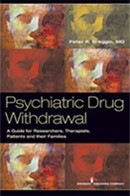$1.6 million TD verdict
When she was twenty-one years old in 1982, Sylvia became anxious and depressed over events in her life. Her internist at the time placed her on Triavil, a combination of the neuroleptic perphenazine (Trilafon) and the antidepressant amitriptyline (Elavil). Although most of her symptoms of anxiety cleared up over the years, her internist maintained her on the drug until he passed away in 1997. According to the standards of modern biological psychiatry, perphenazine is indicated for the treatment of psychosis but at no time in her life has Mrs. Jones displayed any symptoms of psychosis.
In 1997 internist Alan Margolis, M.D. took over Mrs. Jones treatment. Although she no longer suffered from any serious symptoms of anxiety, Dr. Margolis maintained her on Triavil until February 2003 when she developed a severe, painful and crippling torticollis (spasm of her neck). Subsequent physicians diagnosed her as suffering from neuroleptic-induced tardive dyskinesia, a disorder that can afflict any voluntary muscle, including the face, neck, torso, and extremities, as well as speech, breathing and swallowing. The torticollis was a variant of tardive dyskinesia called tardive dystonia.
Since 2003 Mrs. Jones has been completely disabled by a variety of motor abnormalities associated with tardive dyskinesia. In addition to the spasms of her neck, her shoulders twist severely and she has facial and abdominal spasms. Her vocal cords are impaired, producing an abnormal tone of voice. She is weakened and cannot carry out tasks requiring coordination or strength. She suffers from chronic pain. Humiliation over her appearance has caused her to be socially isolated.
Tardive dyskinesia is caused by drugs that block the function of the neurotransmitter system called dopamine. Despite drug company propaganda to the contrary, the so-called atypical or second-generation neuroleptics such as Zyprexa (olanzapine), Risperdal (risperidone), Geodon (ziprasidone), Abilify (aripiprazole), and Seroquel (quetiapine) are potent dopamine blocks and therefore can cause tardive dyskinesia.
Rates for tardive dyskinesia are extraordinarily high: 3%-8% per year cumulative from year to year with the overall risk exceeding 40%-50% in long-term studies. Rates in the elderly are even higher: 20% or more per year cumulative.
In my initial evaluation I found that at no time during his treatment of Sylvia Jones’ did Dr. Margolis adequately justify the use of neuroleptics. He failed to monitor the patient sufficiently, at one point prescribing for her over a period of more than two years without seeing her. He performed no specific examinations for TD, and he admittedly gave no warnings or education concerning the risks and symptoms of TD.
In defense of Dr. Margolis at the trial, a Florida psychiatrist argued that the patient’s TD wasn’t caused by the twenty years of neuroleptic exposure but by the very last dose that the patient supposedly took after her last visit with Dr. Margolis. The effects of the neuroleptics are in fact cumulative over time. A well-known Washington, DC internist argued that Dr. Margolis was not required to give the patient any warnings or education concerning TD since he was certain her original prescriber had given her this information at the start of treatment twenty years earlier. However, the original doctor was deceased and his records no longer existed. Besides, patients and their families need regular reminders about the risks of TD and about how to detect early signs. The internist also argued that Mrs. Jones could have phoned Dr. Margolis any time she developed early signs of TD. But the medical record confirmed that neither Mrs. Jones nor her family had any idea how to identify typical signs of TD.
As a medical expert hired by Mrs. Jones, I conducted the initial evaluation of her medical records and then evaluated her in my office. I provided consultation in planning the case and then in the courtroom during the trial. Originally scheduled as a rebuttal witness to the defense experts, I did not need to testify because the defense was so weak, and Mrs. Jones’ attorney did such a good job discrediting the defense experts, that no rebuttal was required. Two treating physicians testified on behalf of Mrs. Jones.
There have been many previous malpractice verdicts against doctors, hospitals and clinics concerning tardive dyskinesia. I have been involved in half-a-dozen trials that resulted in verdicts for the plaintiffs. Juries have been wise enough to see through distortions and even outright lies by defense experts and have shown sympathy to patients even when they have been stigmatized with diagnoses like schizophrenia. Nonetheless, too many physicians and facilities fail to meet accepted standards for neuroleptic treatment. I continue to believe that the neuroleptics as a group cause more harm than good, and that their use should be curtailed or abandoned. If doctors provided truly informed consent, most patients and their families would refuse to take them. Involuntary treatment with these or any other drugs should be prohibited.
This commentary will appear as a part of Dr. Peter Breggin’s feature column, “Politics, Practice & Breaking News,” in the professional journal Ethical Human Psychology and Psychiatry published by Springer Publishing Company and sponsored by the International Center for the Study of Psychiatry and Psychology (ICSPP). You can support psychiatric reform efforts by joining ICSPP and attending its annual meeting. Membership includes a subscription to the journal where you will find Dr. Breggin’s regular column. For more information, go to the ICSPP website (www.ICSPP.org).





